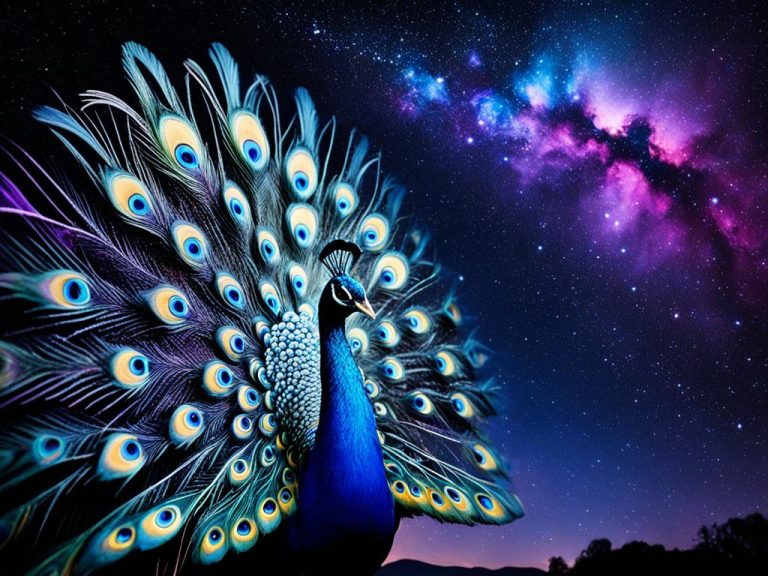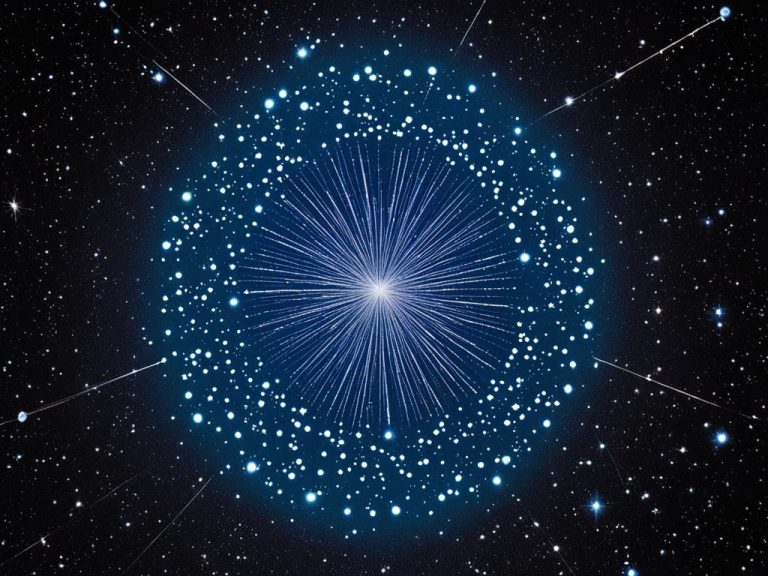Exploring the Wonders of Pavo Constellation
Modified: July 15, 2024 Author: International Star Registry
Did you know the Pavo constellation is named after the Latin word for “peacock”? It shines with some of the most beautiful stars and things in the night sky. This constellation has amazed people who look up at the stars for many years.
The Dutch astronomer Petrus Plancius told us about Pavo in the late 16th century. It’s perfect to see from places with southern latitudes. It sits among the constellations of Telescopium, Octans, Apus, Indus, and Ara. Its special spot gives us a great view of the southern sky. There are so many cool things up there to find.

Key Takeaways:
- The Pavo constellation is named after the Latin word for “peacock.”
- Pavo is best seen from southern latitudes.
- The brightest star in Pavo is Alpha Pavonis, also known as Peacock.
- Pavo contains notable deep sky objects such as the globular cluster NGC 6752.
- Exploring Pavo offers a captivating view of the southern sky.
The Mythology of Pavo Constellation
In Greek mythology, the Peacock is special because of Hera, the goddess. Her servant, Argus, had eyes all over. When he died, Hera turned his eyes into the beautiful feathers of a peacock to remember him. The constellation Pavo stands for this magical bird, guiding Hera’s chariot through the sky.
The stars in the sky make a shape like a peacock. The brightest ones make a triangle for its body. Its tail points to the southeast, making a grand sight at night.
To learn more about Pavo’s myths, and why it’s important, check these links:
- Constellation Guide – This website has everything about Pavo, from its stories to the stars in it.
- Wikipedia – Find out more about Pavo’s history and what it looks like in the sky from this well-known source.
- Britannica Kids – This site tells Pavo’s myths and fun facts in a way that’s easy for kids to understand.
Discover the amazing tales and beauty of the Pavo constellation as you learn more.
The History of Pavo Constellation
The Pavo Constellation has a rich history from the late 16th century. Renowned Dutch astronomer Petrus Plancius found it. He turned his inspiration from Dutch explorations in the south into the shape of a peacock.
It’s not hard to see why Plancius chose a peacock for Pavo. Peacocks stand for beauty, grace, and rareness. This made it a perfect choice to represent the stars.
In 1603, Johann Bayer included Pavo in the Uranometria atlas. This move marked Pavo as an official constellation. From then on, it has delighted astronomers and the public alike with its beauty.
Looking into Pavo’s past is more than just interesting. It shows us the human love of discovering and naming the stars. This points to a shared adventure in understanding the night sky.
Dive deeper into the Pavo Constellation’s story. Explore the myths that make this constellation special. These ancient stories give the stars a magical new depth.
Notable Stars in Pavo Constellation
The Pavo Constellation has many stunning stars that grab the attention of people who love looking at the sky. One star stands out the most – Alpha Pavonis, or the Peacock. It is a pair of stars that are about 180 light-years from us. This star’s bright shine makes the Pavo Constellation even more beautiful from Earth.
In this part of the sky, you’ll also see Beta Pavonis, a yellow dwarf star that glows brightly. Gamma Pavonis, a bigger star, amazes everyone with its light and beauty. Then, there’s Delta Pavonis, a star close to us that makes people who love space very curious.
All these stars make the Pavo Constellation a truly special place in the night sky. Whether you’re a big fan of space or just like looking at the stars, these amazing sights will truly stun you, showing how big and stunning our universe is.
Alpha Pavonis: The Dazzling Peacock
Alpha Pavonis, or the Peacock, shines the brightest in the Pavo constellation. Its name comes from its beautiful blue color and its association with a peacock. The Peacock has two stars – a big yellow one and a smaller blue one. Together, they are a spectacular view in the dark sky.
Exploring Beta, Gamma, and Delta Pavonis
Beta Pavonis, also known as Pavo Australis, is a bright yellow star in the Pavo Constellation. It adds its golden light to the area, making it more beautiful.
Gamma Pavonis is a very big star that adds to the Pavo Constellation’s beauty. Its brightness and look make it shine in the night sky.
Delta Pavonis is a special star closer to us than most in the Pavo Constellation. It is a point of interest for space lovers and astronomers. Its location makes the Pavo Constellation even more fascinating for those exploring the stars.
Deep Sky Objects in Pavo Constellation
Pavo constellation has amazing deep sky objects. They fascinate both astronomers and people who love watching the stars. Two main highlights are NGC 6752 and the Pavo Dwarf Galaxy.
Globular Cluster NGC 6752
The globular cluster NGC 6752 is among the top. It’s known as the “jewel of the southern sky.” This stunning cluster shows us how beautiful tightly packed stars can be.
NGC 6752 is really bright. It’s one of the most noticeable clusters in the night sky. It’s about 13,000 light-years away. With a telescope, you can see its amazing display of stars very clearly.
Pavo Dwarf Galaxy
The Pavo Dwarf Galaxy is also in this constellation. As a small galaxy around the Milky Way, it boosts the area’s charm and potential for exploration.
It’s a tiny galaxy near the Milky Way. But it’s distinct and important for studying galaxies. It helps us learn about galaxy formation and how they change over time.
Discovering deep sky objects in Pavo is an adventure in itself. It helps us appreciate the great beauty of the universe.
Observing the Pavo Constellation
Observing the Pavo constellation is a great experience. It’s the 44th largest out of 88 constellations, covering 378 square degrees. It looks like a peacock, making it easy to pick out.
Pavo is best seen from south of the equator, between 15 and -90 degrees. It is surrounded by Telescopium, Octans, Apus, Indus, and Ara. For the best view, go to a place far from city lights.
Summer is the best time to see Pavo in the southern hemisphere. Its stars shine brightly then. The brightest, Beta Pavonis, is a stunning blue-white. Delta Pavonis, a yellow star, is around 19 light years away.
Pavo features amazing objects you can see. Like NGC 6744, a galaxy similar to our Milky Way. NGC 6782, a bar spiral galaxy 183 million light-years off. And NGC 6872, the Condor Galaxy, with long arms. Also, there’s the star cluster NGC 6752, about 13,000 light years away.
Want to know more about Pavo? You can check out seasky.org, gadgetshint.in, and go-astronomy.com. They offer info on Pavo’s myth, history, and more.
Looking at Pavo will make you appreciate the universe more. It lets us see things not visible from the north. Every sky watcher should enjoy the beauty of Pavo, no matter how much experience they have.
The Astronomical Significance of Pavo Constellation
The Pavo Constellation might not be as famous as others, but it’s key for scientists. It includes deep sky objects like the NGC 6752 and the Pavo Dwarf Galaxy. These help us learn about stars, galaxies, and the universe’s big picture.
The NGC 6752, at about 13,000 light-years, shows ancient star birth and how stars group together. It’s a dazzling spot in the sky for anyone looking up. Scientists also find it very interesting for their studies.
The Pavo Dwarf Galaxy offers insight on tiny galaxies’ roles in the vast universe. It’s a bit over 3 million light-years far. Studying this galaxy helps scientists learn about how galaxies, big and small, evolve and interact.
From the southern part of the world, looking at Pavo has its benefits. The view is clear and perfect for studying or marveling at its beauty. The Southern Hemisphere is the best place to fully see this constellation.
For those who love the stars, Pavo is both exciting and full of learning. The deep sky objects and the chance to see them clearly make it special. It inspires both amateurs and professionals to dive into the universe’s secrets.

Interesting Facts about Pavo Constellation
- The Pavo Constellation was first introduced by Dutch astronomer Petrus Plancius in the early 17th century. The name “Pavo” is Latin for “peacock,” referencing the vibrant plumage of the bird.
- Pavo is one of the 12 constellations created by Plancius while he was working with Dutch navigators on celestial maps.
- The Pavo Constellation is located in the southern sky, predominantly visible from regions near the South Pole.
- With its distinctive shape and bright stars, Pavo is relatively easy to identify in the night sky, provided the viewing conditions are optimal.
Naming a Star in the Pavo Constellation
Want a special and unforgettable gift? Think about naming a star after someone in the Pavo constellation. It’s through International Star Registry. This act lets you honor someone or celebrate an event in the sky.
Naming a star in Pavo is a star gift for life. You get a beautiful certificate. It shows the star’s new name and where it is in the sky. This certificate is a special way to show the star’s meaning and show your care.
It’s great for birthdays, anniversaries, or other big days. Naming a star in Pavo helps celebrate the moment. Your special someone will feel remembered every time they see their star in the sky.
International Star Registry ensures a smooth and professional process. They’ve offered this service since 1979. This makes them a top choice for a genuine and heartfelt gift.
Make the Pavo constellation a part of your story by naming a star. Head to starregistry.com to check out their star-naming options. Find the perfect gift for that someone special.
The Perfect Gift: Naming a Star in the Pavo Constellation
Looking for a special gift? Think about naming a star in the Pavo constellation. It’s offered by International Star Registry. This gift shows love, remembers special times, and honors the beauty of space. It gives a unique bond to the night sky.
Imagine their happiness when they get a star’s name on a lovely certificate. It includes the star’s location and constellation. This special gift lasts a long time and makes a big impact. It’s a great idea for birthdays, anniversaries, or any special day. Naming a star in Pavo shows someone you care deeply.
International Star Registry ensures your star’s name will be kept for the future. They have over 45 years of naming stars. By choosing them, your gift supports space research and learning.
Naming a star in Pavo truly connects someone to the great unknown. It’s a present that will always be treasured. This unique gift highlights their individuality in the universe.
Naming a Star with International Star Registry
Have you ever wanted to give a truly unique and special gift?
Look no further than International Star Registry.
You can name a star in the Pavo constellation. This makes a perfect and everlasting tribute.
Naming a star at International Star Registry is easy and full of meaning.
Just pick a star in the Pavo constellation and give it a personal name.
International Star Registry does the rest. They even give you a beautiful certificate with the star’s new name and location.

International Star Registry has been doing this for over 45 years. They ensure the best quality and real authenticity.
Their named stars database is famous around the world. This makes your gift truly special and memorable.
Want to name a star in the Pavo constellation?
Visit StarRegistry.com to see which stars are available. Start your unforgettable star-naming journey today.
Conclusion
Exploring Pavo’s tales and its place in the sky shows its lasting charm. The stories behind its stars take us back to ancient times. We learn about different parts of our universe, which is vast and beautiful.
Naming a star in the Pavo constellation is a memorable way to celebrate. With International Star Registry, picking your star’s name shows love and bonds us with the stars. It’s a special way to honor someone, with a gift that lives on.
Are you fascinated by the stars, or do you just enjoy looking at them? Pavo has much to offer. Dive into its mysteries from the southern sky. Let its wonder encourage you. What makes Pavo special is how it links us to the cosmos, a connection worth exploring.
FAQ
What is the Pavo constellation?
The Pavo constellation in the southern sky looks like a peacock. It got its name from the Latin word for “peacock.” A Dutch astronomer named Petrus Plancius found it in the late 16th century.
Where is the Pavo constellation located?
You can see the Pavo in the southern part of the sky. It’s visible best from southern places on Earth. It sits between Telescopium, Octans, Apus, Indus, and Ara.
How can I name a star in the Pavo constellation?
Want to name a star? International Star Registry can help. They’ll give you a certificate too, with the star’s new name and where it is in the sky.
Is naming a star in the Pavo constellation a unique gift idea?
Naming a Pavo star is special. It shows love and keeps great memories alive while connecting with the vast universe.
Source Links
- Unveiling the Peacock: A Journey Through the Pavo Constellation. – https://www.gadgetshint.in/2024/02/unveiling-peacock-journey-through-pavo.html
- PAVO Constellation | Expert Resource (2024) – QubeSky – https://qubesky.com/pavo-constellation
